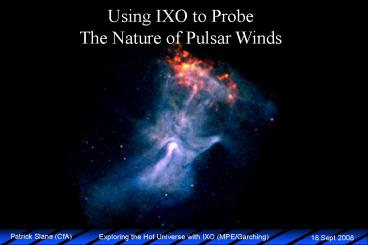Pulsar Winds and Jets - PowerPoint PPT Presentation
1 / 13
Title:
Pulsar Winds and Jets
Description:
Elongated 'cocoon-like' hard X-ray structure extends southward of pulsar ... this is not the pulsar jet (which is known to be directed to NW); presumably the ... – PowerPoint PPT presentation
Number of Views:33
Avg rating:3.0/5.0
Title: Pulsar Winds and Jets
1
Using IXO to Probe The Nature of Pulsar Winds
2
Key Science Points
- PWNe are unique laboratories for studying the
life cycle of energy - - Rotational energy is converted into high
energy radiation and - energetic particles, allowing us to study the
properties of - ? outflows and jets ? termination shocks
? acceleration efficiency - - We know more about the underlying conditions
(mass, spin, magnetic - field strength and geometry) than for any
other systems - PWNe (and their absence) are signposts for young
neutron stars - - Their properties place constraints on initial
spin and magnetic fields - - What is the full census of PWNe in the
Galaxy? - The evolution of PWNe probes the progenitor
structure and environment - - Shocked ejecta reveals composition
Doppler-broadened lines provide - expansion velocities that constrain densities
and evolution - - Nonthermal structure connects emission from
radio to TeV bands
3
PWNe and Their SNRs
- Pulsar Wind
- - sweeps up ejecta shock decelerates
- flow, accelerates particles PWN forms
- - ejecta spectrum constrains expansion
- velocity and progenitor type/structure
- Supernova Remnant
- - sweeps up ISM reverse shock heats
- ejecta ultimately compresses PWN PWN/RS
interaction mixes ejecta into relic PWN
Gaensler Slane 2006
4
PWN Expansion w/ IXO 3C 58
Measurements of PWN evolution and swept-up mass
constrain initial spin and its evolution
energy input and swept-up ejecta mass
PWN evolution
5
PWN Expansion w/ IXO 3C 58
- Chandra reveals complex structure
- of wind shock zone and surroundings
- Spectrum reveals ejecta shell with
- enhanced Ne and Mg
- - PWN expansion sweeps up and
- heats cold ejecta
6
PWN Expansion w/ IXO 3C 58
- Chandra reveals complex structure
- of wind shock zone and surroundings
- Spectrum reveals ejecta shell with
- enhanced Ne and Mg
- - PWN expansion sweeps up and
- heats cold ejecta
7
PWN Expansion w/ IXO 3C 58
- Con-X baseline gives 16000 counts in Ne line in
a 100 ks observation.
- thus, we will get 100 counts from this line in
a resolution element 12 arcsec on a side
8
PWN Expansion w/ IXO 3C 58
- Measure velocity broadening to
- determine age based on size
- - connect with evolution to determine
- initial spin and spindown properties
- Maximum velocities in optical are
- 900 km s-1
- - to detect broadening we need
- resolution of about 2.7 eV
9
PWN/RS Interactions w/ IXO Vela X
t 10,000 yr
t 20,000 yr
t 30,000 yr
t 56,000 yr
Blondin et al. 2001
van der Swaluw, Downes, Keegan 2003
- Vela X is the PWN produced by the Vela pulsar
- - located primarily south of pulsar
- - apparently the result of relic PWN being
disturbed by asymmetric passage of the - SNR reverse shock
- Elongated cocoon-like hard X-ray structure
extends southward of pulsar - - clearly identified by HESS as an extended VHE
structure - - this is not the pulsar jet (which is known to
be directed to NW) presumably the - result of reverse shock interaction
10
PWN/RS Interactions w/ IXO Vela X
LaMassa et al. 2008
- XMM spectrum shows nonthermal and ejecta-rich
thermal emission from cocoon - - reverse-shock crushed PWN and mixed in
ejecta? - Radio, X-ray, and ?-ray measurements appear
consistent with synchrotron and I-C - emission from power law particle spectrum w/
two spectral breaks - - density derived from thermal emission 10x
lower than needed for pion-production to - provide observed g-ray flux
- - much larger X-ray coverage of Vela X is
required to fully understand structure
11
PWN/RS Interactions w/ IXO Vela X
- Thermal properties of ejecta in/around Vela X
constrain the PWN/RS interaction - - expect additional compression and heating as
RS meets PWN - IXO will easily determine plasma parameters
(temperature, density, abundances, - and ionization state) in short exposures (e.g.
Lyb/Lya ? kT, HeaF/R ? net) - - line diagnostics will trace evolution of
ejecta mixed into Vela X - - similar studies will be enabled for other
(much fainter) known systems of this type
12
TeV PWN Counterparts
Lemiere et al. 2008
1 arcmin
- Nearly half of the detected TeV sources are
thought to be PWNe - - no known pulsars associated with most sources
- - X-ray observations reveal faint, extended
nebulae for some - - large FOV and collecting area needed to
identify counterparts - ? ideal for IXO in relatively short (10-100
ks) exposures - Large TeV/X-ray size ratio suggests low magnetic
field - systems, perhaps post-RS PWNe
- - sensitive observations required to establish
counterparts, - and to produce X-ray flux and spectral maps
- - magnetic field related to flux ratio
13
Impacts on IXO Design Requirements
- High throughput and spectral resolution will
allow us to detect the thermal - gas at very faint levels, even in the presence
of synchrotron emission - Line ratios will give temperature modeling
leads to density - - constrain CSM ? progenitor properties
- Velocity broadening gives expansion velocity
- - Issues
- field of view prominent sources are 5 arcmin
or more in size - (may not be a problem with mosaic pointings)
- angular resolution need to resolve small
structure in PWNe - effective area thermal emission is faint
require large areas - spectral resolution need to detect velocities
of lt 1000 km s-1































